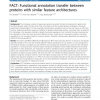350 search results - page 13 / 70 » Hardness Results for Homology Localization |
BMCBI
2010
13 years 7 months ago
2010
Background: The increasing number of sequenced genomes provides the basis for exploring the genetic and functional diversity within the tree of life. Only a tiny fraction of the e...
BMCBI
2008
13 years 7 months ago
2008
Motivation: In the last years more than 20 vertebrate genomes have been sequenced, and the rate at which genomic DNA information becomes available is rapidly accelerating. Gene du...
BMCBI
2004
13 years 7 months ago
2004
Background: Multiple sequence alignment algorithms are very important tools in molecular biology today. Accurate alignment of proteins is central to several areas such as homology...
LPAR
2005
Springer
14 years 26 days ago
2005
Springer
Local search algorithms are one of the effective methods for solving hard combinatorial problems. However, a serious problem of this approach is that the search often traps at loca...
BMCBI
2010
13 years 7 months ago
2010
Background: Determining beforehand specific positions to align (anchor points) has proved valuable for the accuracy of automated multiple sequence alignment (MSA) software. This f...

